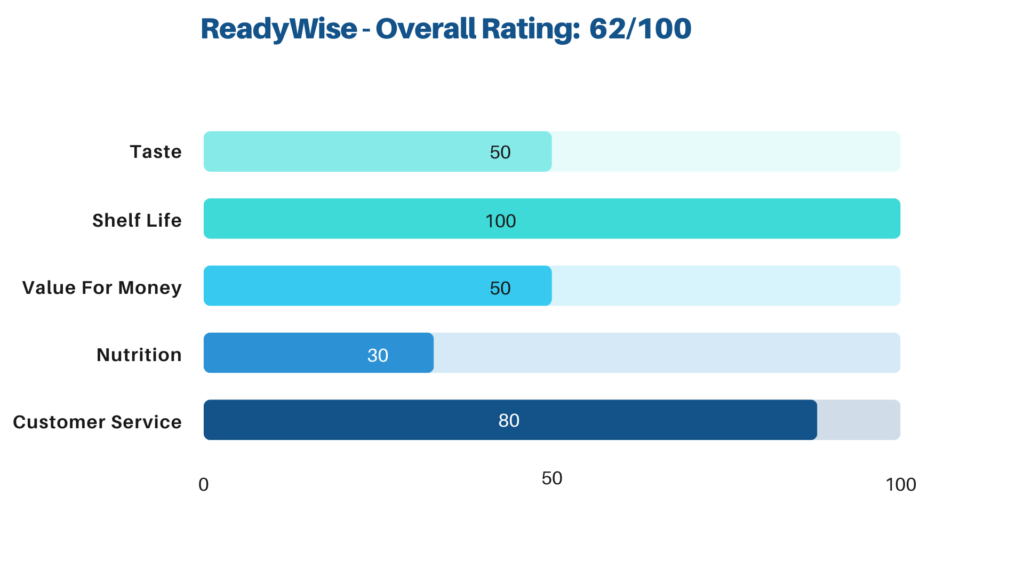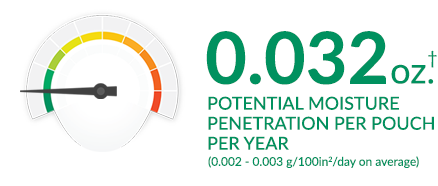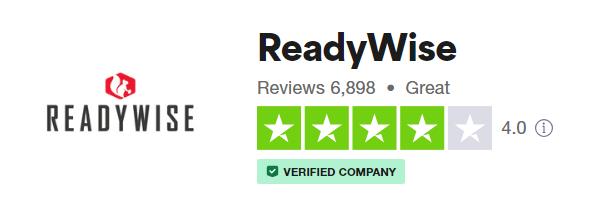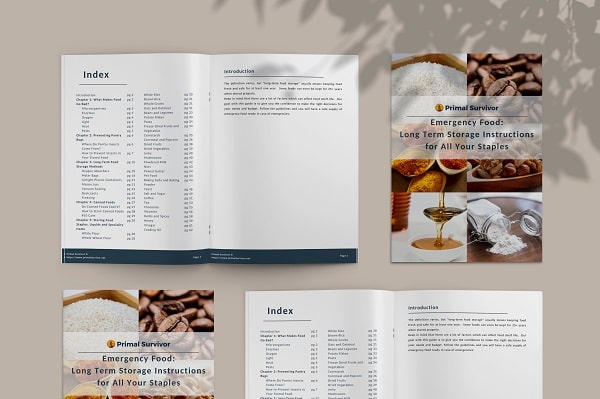ReadyWise (previously known as Wise Food Storage) is one of the best-known emergency food companies and their freeze-dried food buckets are popular with preppers
But how do they stack up on quality, taste, and price against their competitors, and would you really want to eat these meals when SHTF?
Let’s find out…
ReadyWise – Our Ratings

What we think
ReadyWise freeze-dried meal kits are a good option if you want to get prepared for emergencies quickly. They are often on sale, so can be an okay value.
Just be warned that the calories per serving are very low and meals are definitely not nutritious. If you want to take a more DIY approach to build your food stockpile, ReadyWise also has lots of bulk freeze-dried foods in pouches and #10 cans. This route is healthier, and you’ll have more food options.
Key Takeaways
- Great shelf-life and reliable packaging
- Just add water – no cooking required
- Decent value if you can buy the kits on sale
- Meals heavy on carbs without any real meat and few vegetables
- Calories per serving are incredibly low
- Meals are very high in sodium and low in micro and macronutrients
- Calorie and nutrition information can be difficult to find
- Options can be confusing
- Easy to get – full range available on Amazon
What Types of Survival Food Does ReadyWise Offer?
ReadyWise has a very large range of freeze-dried foods. These include various kits, bundles, pouches and #10 cans.
While the variety is great, the options can be somewhat confusing.
For example, you can get a bucket with freeze-dried fruits and vegetables. But you can also get them in #10 cans. Both have similar shelf lives. This leaves it up to you to figure out which is a better deal and makes more sense for your prepping needs.
To make matters worse, ReadyWise is constantly changing what they offer. I get that they need to change their offerings based on availability. That’s fine. But ReadyWise seems to come up with kits as a marketing tactic. Like how they currently have a 72-hour “Zombie” kit. It’s exactly the same thing as their normal 72-hour kit – but the Zombie kit costs more!
Below I’ll go over the 5 main types of emergency food that ReadyWise offers.
1. Long-Term Food Kits
This is the core of what ReadyWise offers: freeze-dried foods and meals which are packaged in pouches and then put in buckets. The shelf life on these buckets is 25 years.
IMPORTANT: Kits By Number of Servings
Most ReadyWise kits are labeled by servings per bucket. Currently, the smallest kit has 52 servings and the largest has 4,320 servings.
This may seem like a lot of food, but ReadyWise serving sizes have very few calories.
How few calories per serving?
- Breakfasts: 190 to 260 calories per serving
- Entrees: 150 to 280 calories per serving
IMPORTANT: Kits By Number of Days
Over the years, ReadyWise has gotten a lot of criticism (including from us at Primal Survivor) for misleading customers about serving size. This is probably why they also started selling kits based on days. They currently have 72-hour, 4-week, 30-day, 3-month and 6-month kits.
These kits have 1,800 calories worth of food per day. According to dietary guidelines, most men need approximately 2,500 calories per day and women 2,000 calories per day. So, the 30-day kit might not actually last you 30 days (or will leave you feeling hungry – see minimum calories per day to survive.)
By contrast, other brands include more calories in their by-day kits. Valley Food Storage, for example, has 2,000 calories per day.
Key Takeaway
Always calculate your own nutritional requirements and plan accordingly. Do not rely on any manufacturer’s definition of serving size when planning your supplies
2. Freeze-Fried Bulk Food Buckets
ReadyWise also sells buckets with freeze-dried bulk foods. These are great if you want to take a more DIY approach to food storage. They are also good for supplementing meals in the kits. For example, you might want to buy a bucket of freeze-dried meat and add it to meals.
Be warned that these buckets are sold by serving size. The calories per serving are very low!
- Meat (flavored chicken and beef – 50 to 170 calories per serving)
- Fruit (strawberries, bananas, peaches, apples, mango, and blueberry and yogurt – 15 to 35 calories per serving)
- Vegetables (corn, peas, broccoli and green beans – 10 to 45 calories per serving)
- Powdered whey milk (70 calories per serving)
- Powdered eggs (80 calories per serving)
3. #10 Cans
ReadyWise also sells some meats, fruits, veggies, dairy and egg powder packaged in #10 cans. There are some options you won’t find in the buckets, like freeze-dried butter, onions and peppers.
ReadyWise isn’t very forthcoming about the shelf life of their #10 cans, but it should also be good for 25 years.
When you calculate the cost per serving, the whey milk is MUCH cheaper in #10 cans than in the bucket kits. The powdered eggs cost the same regardless of whether you buy them in buckets or cans. Yet the fruit bucket kit ends up being much cheaper than buying the #10 cans (Yes, I actually calculated the cost per serving of each fruit!).
These prices change often, so it is worth checking for the best deals at the time of purchase.
4. Simple Kitchen Food Pouches
This line of freeze-dried food by ReadyWise isn’t marketed for emergency prepping. However, the pouches do have shelf lives of 3 years.
So long as you remember to rotate the food, these could be good additions to your food preps – especially since this line has a LOT more options.
I especially love the “treats” like brownie bites, strawberry yogurt tart and apple crisp. These would be a welcome comfort in an emergency situation.
5. Outdoor Foods
ReadyWise also recently started making some “outdoor foods”. These pouches are similar to what comes in their emergency food bundles.
The key differences are:
- Contain meat: Some of the outdoor meals actually contain meat instead of soy protein
- Options: Their outdoor food range also has a few options which aren’t available in the buckets – such as mango sticky rice
- Shelf life: the Outdoor meals last 15 years as opposed to 25 years
- Preparation method: You can prepare the outdoor meals in the pouches instead of needing to pour them into a pot
You can buy individual pouches of ReadyWise outdoor foods (2.5 servings per pouch) or kits with 9 or 13 pouches. Because they are pricier, the adventure meals probably won’t make up the bulk of your food stockpile – but they could be a good addition to it.
Key Criteria and Our Ratings
In this area, we will be focusing mainly on ReadyWise long-term food kits.
Range of meals
Primal Rating:
ReadyWise offers 13 different entrees in the long-term food buckets and 4 different breakfasts.
Breakfasts:
- Apple cinnamon cereal
- Strawberry granola crunch
- Brown sugar maple multi-grain
- Crunchy granola
Entrees:
- Cheesy lasagna
- Pasta Alfredo
- Tortilla soup
- Savory stroganoff
- Chili macaroni
- Southwest rice and beans
- Chicken flavored noodle soup
- Cheesy macaroni
- Potatoes and chicken flavored pot pie
- Tomato basil soup with pasta
- Teriyaki rice
- Loaded baked potato casserole
- Creamy pasta and vegetables
While 13 options seem like it would be a good variety, keep in mind that most of these entrees are just a lot of carbs. There isn’t really much variety in terms of flavor. I recommend you stockpile spices to go with these meals!
Quality and taste
Primal Rating:
Like most food designed to last decades, the meals in the long-term food packs don’t contain any actual meat. Cheese, soy protein, and beans are used as the main sources of protein, but most of the calories come from bulk carbs.
Main meals include a token vegetable or two, but these are booted down to the bottom of the ingredients list in favor of cheaper ingredients. You definitely won’t get your 5-a-day from these meals.
If you prefer organic food, ReadyWise is one of the few companies that offers a certified organic meals bucket (25-year shelf-life). While there’s less variety – you only get 3 choices of entree and one breakfast – the meals contain more vegetables and protein and have a much shorter and more transparent ingredients list than the main meal packs.
So, how do they taste?
Middle-of-the-road is a good way of describing them. As with many brands, some meals are better than others, and clearly, individual tastes and preferences vary!
If you enjoy eating fairly bland comfort food, then you might get on very well with them – and there is definitely a place for comfort food in a survival situation! In particular, the chicken noodle soup and cheesy macaroni compare well to other brands. The apple cinnamon cereal is also a tasty option.
At the other end of the scale, the chili mac gets the thumbs down from most taste testers.
Aside from the lack of spice and flavor, the other downside (depending on your palate) is that a lot of the meals taste very salty. It’s worth playing around with the cooking times and the amount of water you add so you don’t end up with soggy pasta.
Ease of Cooking
Primal Rating:
Here is one area where ReadyWise really shines. All of their meals can be made with just water – no cooking is required! This is particularly great if you don’t have an emergency stove or are unable to use a stove (such as when there is a suspected gas leak).
You can make the meals simply by covering them with water and waiting for the ingredients to reconstitute. The meals are going to taste better if you use hot water, but they can even be prepared with cold water.
Gluten-free or Vegetarian Options?
Primal Rating:
All of ReadyWise’s regular meals contain wheat, but the good news for those that follow a gluten-free diet is that they have a special gluten-free bucket. This contains five different entrees (three of which are also vegetarian) and a “creamy yogurt style” dessert, which could double as breakfast (though note this only has 50 calories per serving).
The bulk fruit, vegetables, powdered milk, and powdered eggs are all gluten-free, though the freeze-dried meat is not. Check out our article on gluten-free emergency food for more long-term food options.
Vegetarians are reasonably well catered for with the regular meals. 10 of the 13 entrees are vegetarian, and all the breakfast options.
Vegans and those with other allergies are going to struggle. All the meals contain milk, and although none specifically contain nuts, they’re produced in a factory that handles tree nuts, peanuts, shellfish and fish, so there’s a risk of cross-contamination.
Realistically, this is likely to be the case with most emergency meals, so if you have a complex diet, you’re better off sourcing individual ingredients and making your own meals.
How Healthy Are They?
Primal Rating:
The main thing that strikes me about the ingredients list of ReadyWise’s emergency meals is that I don’t know what half the ingredients actually are. I appreciate that certain preservatives are necessary for food with extremely long use-by dates, but trying to figure out what’s actually in the food you’re eating feels a bit like struggling with a high school chemistry class.
It also doesn’t reassure me about how healthy this food is. What it does tell me is that these meals are highly processed with cheap additives such as maltodextrin and corn syrup to act as thickeners and sweeteners.
Let’s get onto the nutritional labels. We’ve already covered calories per serving, so I’m not going to go into that again.
Carbohydrates and Sugar
As you might expect, the meals are fairly carbohydrate heavy, but the amount of sugar varies considerably. All the breakfast options are high in sugar (having around 24g of sugar per 100g), but a few of the entrees – the Loaded Baked Potato Casserole, Cheesy Lasagne, and Teriyaki and Rice – also contain a surprisingly high amount of sugar. Even some of the freeze-dried fruits have added sugar!
Protein
ReadyWise entrees have approximately 4-9 grams of protein per serving. Breakfasts have approximately 7g per serving.
This isn’t a terribly-low amount of protein, especially if you are just sitting out an emergency. But, if you are active (such as needing to chop wood or do repairs during an emergency), you would need significantly more protein.
You might consider getting one of the ReadyWise meat bundles to add to the meals to increase the protein content.
Sodium
ReadyWise meals have a huge amount of sodium. Most entrees have more than 600mg of sodium per serving. Since the calorie amount is so low, you’ll probably need to eat two servings – which means over 1,200mg of sodium.
The Institute of Medicine recommends that adults only eat 1,500mg of sodium per day!
Some meals have even higher amounts. The Savory Stroganoff, for example, has 750mg of sodium per serving. This could be dangerous for people with cardiovascular problems.
Vitamins and Minerals
There are virtually no vegetables in ReadyWise meals -which means that there are virtually no vitamins or minerals. You might want to stock up on multivitamins!
Shelf Life
Primal Rating:
When it comes to shelf-life, ReadyWise is fantastic. They pack their meals in Metallyte™ pouches, a high-quality high barrier film that provides exceptional oxygen and moisture protection.
The pouches have been independently tested by Silliker Labs, which gives us some confidence in the claimed 25-year shelf life.

Shelf Life of ReadyWise foods:
- Meals: 25 years
- Meat: 15 years
- Fruit: 20 years
- Vegetables: 25 years
- Eggs: 25 years
- Outdoor meals: 15 years
- Everyday Pouches: 3 years
Each bucket contains 30 pouches. As the serving sizes are so small, you’ll likely use up at least one pouch per meal, so you won’t have to worry about having to eat the same meal multiple times in a row.
The buckets are pretty sturdy and light enough to easily grab and move in an emergency. As with all emergency foods, they’re best stored in a cool, dry place.
Cost and Value for Money
Primal Rating:
It’s no secret that freeze-dried emergency meals don’t come cheap. Compared to other brands, Readywise comes out in the middle cost-wise per serving (see our full comparison here). The price ends up being around $2.20 to $2.60 per serving.
They are known to have good sales occasionally, so if you’re willing to wait a bit to stock up, they could end up cheaper than most other brands.
But remember that the calories per serving with ReadyWise are much lower than with most other brands. When you calculate cost per calorie, the price is much higher.
Cost is just one factor. As for value, ReadyWise also falls short. This is because the calories in their meal mostly come from cheap carbs. There is no actual meat in any of the emergency meals, and there is little in terms of fruits and vegetables.
You end up paying a very high amount for what is essentially glorified pasta or rice. Of course, this is the case with most emergency food brands – but a few brands do use better-quality ingredients in their meals, and thus are a better value.
Availability
Primal Rating:
You can buy Wise food directly from Amazon, Walmart and Home Depot.
Bear in mind that during hurricane season or other disasters, emergency food sells out quickly. Buying at a quiet time of year means you’ll get your food quicker and may be able to take advantage of sale prices.
Customer Service and Incentives
Primal Rating:
ReadyWise has more than 6,000 reviews on Trustpilot, with 81% of reviewers rating them as Excellent or Great. The negative reviews are mostly due to delayed shipping times and poor communication during exceptionally busy periods. If you’re prepped and are buying your supplies ahead of time, this shouldn’t be an issue.

Final Thoughts
When you calculate cost per calorie (and not their small serving size), Wise emergency food is an okay mid-budget option for emergency meals – especially if you can get one of their bundles on sale. The taste isn’t bad, the meals are easy to prepare and they have an impressive shelf life.
Just be realistic about how suitable these meals are for long-term emergencies. The nutrition specs are terrible, so you’ll want to supplement meals with some bulk freeze-dried ingredients. And, as always, make sure you actually tally up your daily calorie needs instead of relying on the listed servings.
Related
For further survival food company reviews see:






bought 4 buckets a few years ago, and as I’m planning a camp trip to bear country, thought I’d try a couple before hand. Not real good. In fact, think I’ll take some anyway, hoping the bears DO get it.
Would serve them right…
Question,
which long term emergency food company would you consider tops when compared to Wise and others… Quality, calories, price and shelf life?
We did a detailed review on our favorite brands here: https://www.primalsurvivor.net/best-emergency-food-reviews/ It goes into calories, sodium, price, etc. For bulk ingredients, I like Augason because they have a lot more variety than other brands. For meals, Valley Food Storage is a good alternative to Wise.